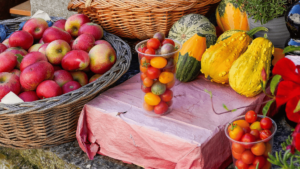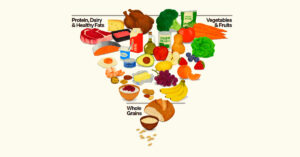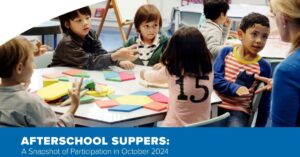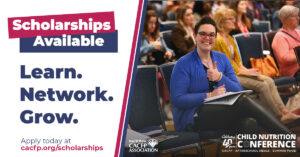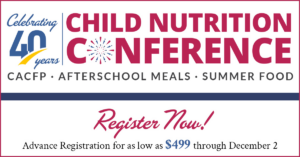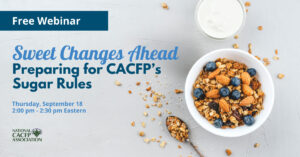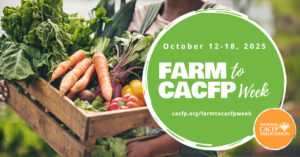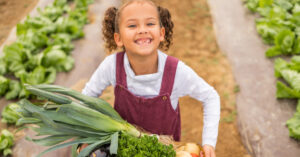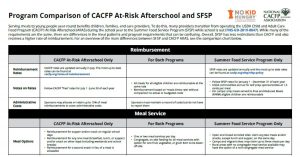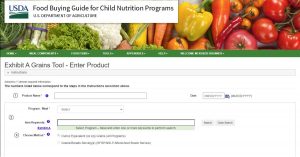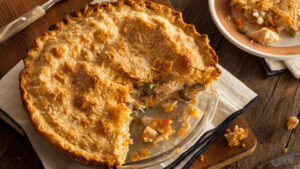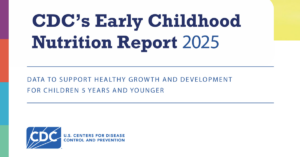Can you purchase local, CACFP creditable foods from a farmers market?
Read MoreOn January 7, 2026, USDA and HHS released the 2025-2030 Dietary Guidelines for Americans. The 2025-2030 DGAs recommend prioritizing high-quality protein, healthy fats, fruits, vegetables and whole grains, while avoiding highly processed foods and refined carbohydrates.
Read MoreThe Food Research and Action Center (FRAC) released their Afterschool Supper report that snapshots participation in October 2024. They found that afterschool supper participation has increased and that CACFP represents 50% of the daily participation.
Read MoreCan all ingredients in a smoothie be credited in the CACFP?
Read MoreThe Stanford Center on Early Childhood released a RAPID report that looks at how issues of food insecurity and hunger are affecting adults who provide care for young children. Their key finding: hunger is on the rise among child care providers.
Read MoreThe National CACFP Association (NCA) is proud to continue its annual scholarship program for the 2026 National Child Nutrition Conference (NCNC), taking place April 13–17, 2026, in Las Vegas, Nevada.
Read MoreWe are closely monitoring the potential government shutdown on October 1 and its impact on the CACFP. As your trusted partner, we’ll keep you informed with timely updates.
Read MoreOver 2,000 key stakeholders and professionals from the Child and Adult Care Food Program (CACFP) and Summer Food Service Program community will convene for a week of nutrition education and professional development at the 40th annual National Child Nutrition Conference (NCNC) in Las Vegas, Nevada, from April 13–17, 2026.
Read MoreRegistration for NCNC26 is now open! Get ready for our 40th Anniversary – five days of training, networking and fun.
Read MoreBeginning October 1, 2025, the Child and Adult Care Food Program (CACFP) will implement new regulations requiring limits on added sugars in breakfast cereals and yogurts served in child and adult care settings.
Read MoreThis October marks the inaugural Farm to CACFP Week, hosted by the National CACFP Association to celebrate the benefits of connecting child and adult care programs with local foods.
Read MoreUSDA updated previous guidance on Feeding Infants in the CACFP. Updates include information on medical statements, substituting vegetables for grains in specific groups, added sugar limits, and tofu and tempeh crediting.
Read MoreThe USDA released a memorandum to provide updated guidance on the provisions of the 2024 final rule that apply to the grains requirements in the CACFP, which included adding a definition for whole grain-rich into CACFP regulations; changing product-based limits for breakfast cereals and yogurts from total sugars to added sugars; and updating guidance on substituting vegetables to meet the grains requirements for eligible program operators.
Read MoreThe new year is just around the corner, which means this is the perfect time to reflect. What you do matters. Take a moment and really think about how your work impacts those that you serve, whether it’s the children or adults in your care, providers that you support, or sponsoring organizations you work with. Share your story with NCA!
Read MoreUSDA released a Notice of Funding Opportunity on December 10, 2024, for State agencies to access funds to purchase and distribute local foods for schools and CACFP child care providers in their state. USDA has committed $188.6 million specifically for institutions participating in the CACFP. State agencies must submit a proposal in order to access these funds for the schools and CACFP providers in their state and there can only be one application per state. Funds will be awarded through a non-competitive process based on a formula using the meal counts of participants of the CACFP in each State. Cooperative agreements will be for a period of three years from the time of award.
Read MoreNovember 7, 2024 The USDA released a memorandum to provide additional information and clarification on the state agency monitoring process regarding the: 1) Child nutrition (CN) label, 2) Watermarked CN label, and 3) manufacturer’s Product Formulation Statement (PFS). This memorandum also reflects updates to the CN Label Verification System and provides clarification on the date…
Read MoreCACFP and SFSP operators that primarily serve American Indian or Alaska Native participants can substitute ½ cup of any creditable vegetables or 1 cup of raw leafy greens for 1 oz eq of grains. Vegetables substituting as grains can be used to meet the whole grain-rich requirement in the CACFP. There is no limit to the number of times per week that vegetables may be substituted for the grains requirement.
Read MoreExciting news! Head Start programs have an opportunity to access one-time supplemental funds to support nutrition services and healthy eating for enrolled children and families. You can use this funding for staff training on resources and educational opportunities to help your program improve outcomes for children and families and align with USDA requirements – like the CACFP!
Read MoreThe Child and Adult Care Food Program has new creditable foods listed on the USDA Food Buying Guide! If you are new to the FBG, this interactive tool allows for easy display, search, and navigation of food yield information. In addition, users can compare yield information, create a favorite foods list, and access tools, such as the Recipe Analysis Workbook (RAW) and the Product Formulation Statement Workbook.
Read MoreThe Child and Adult Care Food Program community asked for more Spanish resources to be available on the National CACFP Sponsors Association website and we heard you! Available now in Spanish are more resources to help sponsors and providers with meal pattern requirements, best practices, and so much more!
Read MoreServing meals to young people year-round benefits children, families, and care providers. To do this, many providers transition from operating the USDA Child and Adult Care Food Program (CACFP) At-Risk Afterschool (ARAS) during the school year to the Summer Food Service Program (SFSP) while school is out. For an overview of the main differences between SFSP and CACFP ARAS, see the comparison chart below.
Read MoreNCA understands that the end of flexibilities will cause challenges for many CACFP sponsors and providers and we commend your continued commitment to providing nutritious meals and snacks to the children or adults in your care. In preparation for the end of the additional reimbursement, we have collected the following resources to help you successfully provide meals even if your available budget decreases.
Read MoreCan you purchase local, CACFP creditable foods from a farmers market?
Read MoreCan all ingredients in a smoothie be credited in the CACFP?
Read MoreCan a parent or guardian supply a meal component for their infant in the infant meal pattern?
Read MoreCould the crust of a chicken pot pie credit as the grains component?
Read MoreAre juice cocktails creditable in the CACFP?
Read MoreIs raw cow’s milk creditable in the CACFP?
Read MoreExciting news! Head Start programs have an opportunity to access one-time supplemental funds to support nutrition services and healthy eating for enrolled children and families. You can use this funding for staff training on resources and educational opportunities to help your program improve outcomes for children and families and align with USDA requirements – like the CACFP!
Read MoreThe Child and Adult Care Food Program has new creditable foods listed on the USDA Food Buying Guide! If you are new to the FBG, this interactive tool allows for easy display, search, and navigation of food yield information. In addition, users can compare yield information, create a favorite foods list, and access tools, such as the Recipe Analysis Workbook (RAW) and the Product Formulation Statement Workbook.
Read MoreThe Child and Adult Care Food Program community asked for more Spanish resources to be available on the National CACFP Sponsors Association website and we heard you! Available now in Spanish are more resources to help sponsors and providers with meal pattern requirements, best practices, and so much more!
Read MoreServing meals to young people year-round benefits children, families, and care providers. To do this, many providers transition from operating the USDA Child and Adult Care Food Program (CACFP) At-Risk Afterschool (ARAS) during the school year to the Summer Food Service Program (SFSP) while school is out. For an overview of the main differences between SFSP and CACFP ARAS, see the comparison chart below.
Read MoreNCA understands that the end of flexibilities will cause challenges for many CACFP sponsors and providers and we commend your continued commitment to providing nutritious meals and snacks to the children or adults in your care. In preparation for the end of the additional reimbursement, we have collected the following resources to help you successfully provide meals even if your available budget decreases.
Read MoreThe Food Research and Action Center (FRAC) released their Afterschool Supper report that snapshots participation in October 2024. They found that afterschool supper participation has increased and that CACFP represents 50% of the daily participation.
Read MoreThe Stanford Center on Early Childhood released a RAPID report that looks at how issues of food insecurity and hunger are affecting adults who provide care for young children. Their key finding: hunger is on the rise among child care providers.
Read MoreUSDA released their second report on the Study of Nutrition and Activity in Child Care Settings (SNACS-II), which follow their first in 2022. SNACS-II uses data from program year 2022-23 to assess how well children’s diets and CACFP meals align with the Dietary Guidelines for Americans.
Read MoreA recent study by our partners at Child Care Aware® of America reveals that parents across the nation are struggling to find affordable, high-quality child care. The survey shows that parents are piecing together multiple care arrangements and facing challenges balancing work and caregiving.
Read MoreThe CDC’s 2025 Early Childhood Nutrition Report gives us a big-picture look at how young children in the U.S. are eating and growing. It focuses on kids from birth to age 5 and shares important facts about breastfeeding, starting solid foods, eating healthy and how states support good nutrition.
Read MoreThe “Characteristics of Emergency Shelters Participating in the CACFP” study by USDA seeks to better understand the characteristics of CACFP emergency shelters, who they serve, how CACFP fits into their operations, and their challenges with CACFP. The study was conducted in 2023 and collected data from 242 emergency shelters that participate in CACFP in Fiscal Year 2023.
Read More
